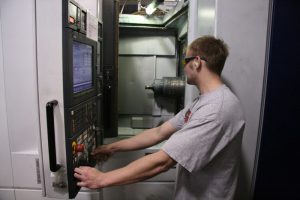 Jack repairs machines as they break
Jack repairs machines as they break
Do you remember Jack from my post on maintenance magic? When we last left Jack, he was trying to repair machines in a firefighting pattern of repair/break/repeat that just wasn’t working.
Today, Jack is taking several days to resurrect his company’s monument machine from the dead.
“I’ll need a dumpster and a shovel, some scrapers, solvent and a case of clean rags.” Jack rolled over a huge tool box with grease guns draped across the side, lock out tags and lift traps hung across the back. He smiled. “I can’t get anything done without the battle wagon!”
He began to dig and dig and scrape. “Twenty years of rusted chips, dried up coolant, sludge and grime has gotta come off so I can get to the machine.”
As he chiseled away, the silhouette of the monument slowly changed from a curvy bell shape to a prestigious, sharp-edged piece of art.
“Looks like I remember her! She’s a beauty!” He pulled out the maintenance manual and explained, “now I can see to inspect all the major systems: the main body, electrical (motors, controls and wiring), hydraulics, bearings, ball screws, lubrication system, gibs, pneumatics and stuff like guards, interlocks and safety devices.”
With a dial indicator in one hand and a rag in the other, Jack started the tedious process of removing way covers to gain access to the ball screws. “Looks like the coolant has washed chips into the carrier and it’s jammed up and packed around the screw. You would figure the operator would have heard something before it got this bad. Just look at all these safety hazards too!”
Trip hazards, slippery floors, missing guards and sharp edges were abundant.
Moving past the repair-break-repeat cycle
As I discussed in the last blog, an unplanned breakdown costs 4 to 5 times that of a planned maintenance activity. 30% of breakdown expenditures are unnecessary and therefore waste resources and time. This is a perfect example of that scenario.
So how do you move past this cycle? You start where Jack did – clean up the machine as best you can.
Document it: pictures are worth more than words
After cleaning up your machine, document the before and after process so that others can perform the task at a later date. This gives them visual cues for what ‘clean’ actually means. Photo documentation is also a great great way to underscore the stark realities of failing or neglected machinery. With photo evidence, others understand why seemingly small problems add up to huge costs in the long run.
Safety first: regularly inspect and maintain machines
As you work, make a list was of the safety issues you discover. Regular inspection decreases safety incidents significantly. Fresh paint, clean machines, and clear guard rails are important, not just because they look nicer, but because they are visual reminders of how to properly care for and maintain the machine.
Set up for future success: schedule your plan
Take the time to compile a list of required parts for your machine, and keep track of any downtime. Then, log your hours spent maintaining the machine. Armed with the new knowledge, as well as the safety items you wrote down earlier, you can now develop a scheduled plan for preventive maintenance based on the manufacturer’s recommendations, as well as your own findings and experience.
Create a visual management system
Finally, consider how others are interacting with the machine on a daily basis. In our story, Jack built new guards with see-through inspection ports, and painted the entire machine. Find ways to make the machine stand out so it is seen, not simply ‘background noise’.
Partner with co-workers on preventative maintenance
Bringing in team members for maintenance issues is a huge win. I’ll let Jack explain this part.
“In retrospect, I couldn’t have done it without the help of the operators. Working as a team, we completely restored the machine for 30% of the cost of a new one.
We cleaned to inspect it, and made a separate list of worn and damaged components. We also made a list of things that were outdated or could be improved. Because we had the operator’s input, we were able to determine the autonomous maintenance and cleaning requirements for daily preflight!”
Set expectations about regular preventative maintenance
When you’ve completed these steps, take a step back. Congratulations! You’ve just set new expectations for your company’s lean journey. Share your results with others so they can learn, and adopt your methods. If Jack were telling the story, here’s what he would report:
- We restored the monument to “better than new” condition for 1/3 the cost of a new one
- We identified 8 major safety problems that were eliminated
- The quality reject rate has been reduced by 25%
- Productivity has improved by 27%
- Budget included control and drive upgrades that reduce our power requirements and improved ease of operation
- Preventive maintenance procedures were developed to sustain the monument at the lowest cost per unit
- Critical spares are identified and budgeted for
- Unplanned down time has been virtually eliminated
- Housekeeping audits improved by 35 points
- Visual standards showing expectations are permanently posted
- Operator morale has skyrocketed
- Counting the downtime, lost production, total labor and cost of parts, cost per unit dropped 6% at current production rates
With a regular preventative maintenance plan in pace, you can expect long term success.



